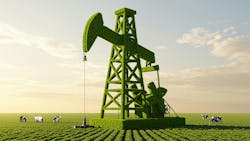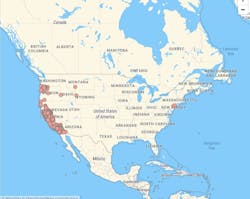What you'll learn in this article:
- What renewable diesel is and how it compares to diesel
- How renewable diesel can benefit a fleet
- How the fuel source is produced and brought to market
Reducing your carbon footprint doesn’t always mean your fleet has to invest hundreds of thousands of dollars in new trucks, repair tools, and technician training. Making the change from conventional diesel to renewable diesel (RD) has proven to reduce greenhouse gas (GHG) emissions, and could even lead to reduced maintenance costs. The best part is that fleets don’t have to do a thing to begin fueling their diesel trucks with RD—except find a reliable place to buy it.
Unlike fossil fuels that come from the ground, RD essentially comes from farms, since its primary “ingredients” are things like beef tallow and used cooking oil, or other oils derived from animals and plants. That’s a big reason why RD can help a fleet achieve a 60 to 75% GHG emissions reduction over the fuel’s lifecycle, noted Peter Zonneveld, president of Neste US, a producer of sustainable aviation fuel and renewable diesel.
Zonneveld also noted that the chemical compositions of petroleum and renewable diesel are largely similar, allowing a straight swap to RD without any fuel additives, engine modifications, or blending—hence the term “drop-in” fuel. “The big difference is that RD doesn’t have the aromatics, which are what create the smoke and are potentially carcinogenic,” he said.
And based on the realized benefits, a wise use of this extra time would be to explore if renewable diesel is right for you. The alternative is stagnation, never a successful strategy in the transportation industry, or heavily investing in battery-electric trucks and associated charging infrastructure. Let’s dive more into the pros of renewable diesel, as well as what’s working against it blossoming.
Making the switch
For fleets looking to reduce their environmental impact and transition away from fossil fuels, a drop-in replacement like RD provides a relatively painless way to do so—unlike with BEVs, which require a significant investment.
“Convincing fleets to switch to RD is not as difficult as you might think,” said Marci Ballard, director of corporate development at Christensen, a fuel and lube supplier based in Washington state. “In some cases, RD is a superior product. But the big thing is that it’s a drop-in replacement. One day a fleet could be using [ultra-low-sulfur diesel], and the next day they could be using RD—and right back again, if they wanted. Regardless, the fleet will see zero complications. That’s much different than if they’re trying to move from USLD to a heavy biodiesel.”
Switching to a steady diet of animal- and vegetable-based fuel also trims some fat off maintenance budgets as well.
“Because it has so few impurities, RD is keeping our customers’ engines much cleaner,” Ballard said. “Some customers tell us they’re extending oil drains; some are reducing DPF changes. They’re saving money on maintenance by switching to RD.”
Zonneveld concurred.
“We’re starting to see a lot of evidence that points to reduced maintenance costs,” the Neste US president asserted. “A former customer of ours in Oregon, Titan Freight Systems, told us they’d seen a 1.5-cent-per-mile cost savings in exhaust system maintenance due to less frequent filter changeouts.”
Before finding a renewable supplier, though, it’s important to know a little about what it is and isn’t.
It should be noted that RD and biodiesel are not one and the same. Yes, they are both made from biological sources like vegetable oils and animal fats, so RD is technically a type of biodiesel. However, due to the way it is processed, RD is actually more like regular petroleum diesel in many respects.
Biodiesel is a mono-alkyl ester produced via transesterification, where a feedstock chemically reacts with an alcohol, such as methanol, in the presence of a catalyst, such as lye. Biodiesel meets ASTM D6751 and is approved for blending with petroleum diesel.
RD is a hydrocarbon produced most often by hydrotreating, where lipids from feedstocks of vegetable or animal waste products are reacted with hydrogen under high temperatures and pressure to remove water and oxygen. Hydrotreating is the same process used in existing petroleum refineries. Furthermore, RD meets the same ASTM D975 specification for petroleum diesel. Thus, RD can either be blended with regular diesel or used all by itself as a direct replacement. A label reading “R100” means it’s pure renewable diesel, while R20 would be 20%, with petroleum diesel at 80%.
No chain, no gain
According to the Alternative Fuels Data Center of the U.S. Department of Energy, RD production in the U.S. grew from a little more than 500 million gallons in 2020 to more than 2.5 billion in 2023. Consumption more than tripled to nearly 3 billion gallons. Still, RD is taking a small bite out of the entire diesel-consumption pie.
“If you want to replace a high percentage of the 40 billion gallons of diesel that are consumed, you have to come up with a lot more oil that doesn’t come from the ground,” said Kevin Otto, electrification technical lead at the North American Council for Freight Efficiency (NACFE).
Supply is partly why UPS, a large user of Neste’s NEXBTL RD a decade ago, has opted to focus more on renewable natural gas. RNG also offers “a 90% reduction in lifecycle greenhouse gas emissions when compared to conventional diesel,” noted Mike Whitlatch, VP of global energy and procurement, UPS, in 2022.
On a positive note, existing refineries can convert parts of their current operations to produce RD, which is naturally faster and less expensive than building a new facility from the ground up. More conversions have been taking place, but more will be needed. “They all can do this, but the question is, will they?” Otto wondered.
The way RD is brought to market is also business as usual, for the most part. Any gas station can choose to offer RD using the same diesel pumps and tanks they already have. “Additionally, fossil fuel distributors are beginning to add RD onto their product slates,” Neste’s Zonneveld pointed out.
Driven by state regulations, RD is primarily utilized in California, Oregon, and Washington. Thus, it stands to reason that the majority of production plants and fueling stations are located in those states. However, interest is growing in other areas of the country. Case in point, the Alternative Fuels Data Center (AFDC) shows that through 2023 production plants existed in the states of not only California and Washington, but also Oklahoma, Louisiana, Kansas, New Mexico, Wyoming, North Dakota, and Montana. Additionally, Neste opened a MY RD fueling station in New Jersey in 2024.
Despite the progress made over the past five years, a supply challenge is beginning to take shape. A change in the federal tax code is now incentivizing domestic production of RD. Prior incentives were directed toward blenders who were able to utilize imported RD in their blending efforts. “Now we are looking at a roughly 2-billion-gallon reduction in imported supply that’s driven by that tax credit change,” Christensen’s Ballard said.
The hope is that domestic production will continue expanding and eventually offset that reduction in imports. Neste is doing its part. With overseas refineries in Finland, the Netherlands, and Singapore, the RD producer has also opened a production facility in Martinez, California, as part of a joint venture formed with Marathon Petroleum in 2022. Additionally, to strengthen its own supply chain, several acquisitions have helped broaden Neste’s access to used cooking oil and residue fats that are needed to produce RD. One example is the 2020 acquisition of Mahoney Environmental, which recycles used fryer oil, cooking oil, and grease trap material.
Neste’s ramp-up of U.S. production comes at an important time. It’s an important step toward ensuring a reliable supply of RD for fleets, especially fleets that are looking to take an important step toward reducing their carbon footprint.
About the Author

Gregg Wartgow
Gregg Wartgow is a freelancer who Fleet Maintenance has relied upon for many years, writing about virtually any trucking topic. He lives in Brodhead, Wisconsin.


